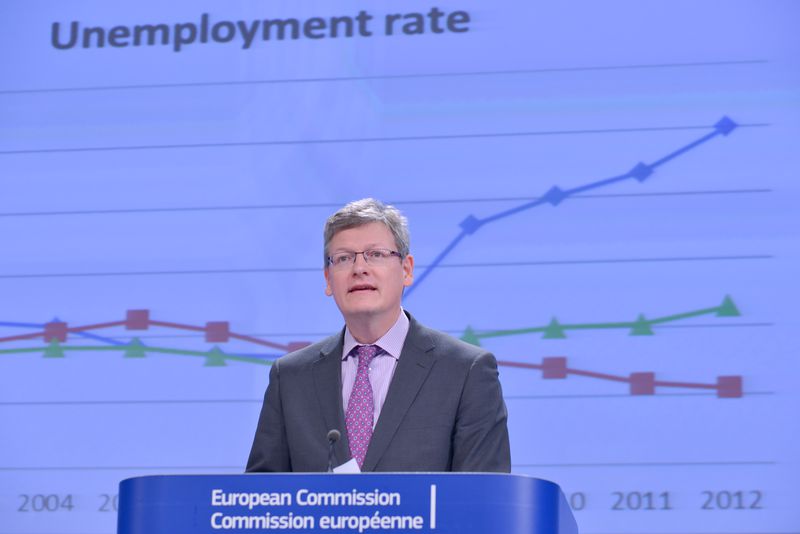EU's Social Pillar - the Last of the Mohicans of National Sovereignty
Adelina Marini, October 7, 2013
 In February 2012, the governor of the European Central Bank, Mario Draghi, pronounced the famous European social model dead because of the huge youth unemployment which spread throughout EU. Later, in a separate article, Mr Draghi pointed out that the deepening of the European integration will not be the end, but the rebirth of the European social model. The article was published on the eve of a series of proposals on the deepening of the European integration which became known as a combination of unions - economic, fiscal, banking and even a political union. The social element started drawing attention in the end of last year when as a result of the austerity measures unemployment reached record high levels in all most affected by the crisis member states.
In February 2012, the governor of the European Central Bank, Mario Draghi, pronounced the famous European social model dead because of the huge youth unemployment which spread throughout EU. Later, in a separate article, Mr Draghi pointed out that the deepening of the European integration will not be the end, but the rebirth of the European social model. The article was published on the eve of a series of proposals on the deepening of the European integration which became known as a combination of unions - economic, fiscal, banking and even a political union. The social element started drawing attention in the end of last year when as a result of the austerity measures unemployment reached record high levels in all most affected by the crisis member states.
In July 2013 the number of jobless in the 28 EU member states was 26.5 million people of whom 19.2 million in the euro area only. A quarter of the economically active young population in Europe is without a job - 23.4 per cent or 5.6 million in EU28 and 24% (3.5 million) in the euro area (EMU17). Poverty and social exclusion are on the rise since 2009, especially in the southern and eastern members of the Union. Because of these challenging for the political stability data, the member states tasked the Commission and the European Council President Herman Van Rompuy to come up with concrete proposals to enhance the social aspect of the measures to overcome the crisis. As a first step and quite ad hoc has been agreed the Youth Unemployment Initiative worth 6 billion euros.
After consultations with the member states and on the basis of the Parliament's ideas and some individual positions, the European Commission presented last week the "social dimension of the EMU". The proposal has the ambition to be the fifth pillar of the European integration, but practically it will be the last of the mohicans of national sovereignty. In the document of almost 20 pages it is underlined a number of times that whatever is to be done it will be largely related to dialogue and debates, rather than real actions at European level, and that national competences will be fully respected. It is pointed out that the employment policies are entirely under the jurisdiction of the member states, which is why the Commission proposes initiatives that will only draw the attention to the problems in EU.
That is why all the ideas are meant to be integrated into the European semester and spread only to supervision and coordination without any sanctions for non-compliance, as is the case with some fiscal policies, for instance. What is proposed is the indicators that are monitored in the framework of the Annual Growth Survey and the Macro-Imbalances Procedure to be increased. The main points in the document are strengthening supervision on the challenges for employment and social policy and coordination of policies; enhancing solidarity and actions in support of labour mobility; increasing social dialogue.
While reading the document one is left with the impression that it admits the failure of the ten-year-long economic strategy of the EU, Europe 2020, drawn on the basis of expectations that have nothing to do with the situation the crisis from 2009 created. As if feeling that this key document will be thrown into the recycle bin, the Commission explicitly notes that the ten-year vision, which succeeded the Lisbon Strategy for growth, has put for the first time social policy into the heart of the European economic strategy and that, in fact, the social dimension of the EMU will help the member states achieve the 10-year goals that envisage the employment of the population between 20 and 64 years to reach 75% and those at risk of poverty to decline by 20 million.
The outcome of the first 3 years of the work on Europe 2020 is record high levels of long-term unemployment in the entire EU, a permanent growth of poverty since 2007, which has led to 24.2% of the EU population to be at risk of poverty and social exclusion. Only in Greece the share of young people without a job is 63% of the overall number of jobless people in that country. The Commission, though, is not discouraged by this and believes that the social dimension can help all this to be overcome. For the purpose, it proposes the following additional indicators to be included in the European Semester:
- participation rate on the labour market;
- long-term unemployment rate;
- youth unemployment rate to also include those involved in education;
- risk of poverty and social exclusion rate.
According to Commission data, the level of trans-border labour mobility in the EU is still very low. Only 2.6% of the population of the Union has moved to live in another member state. And in the eurozone less than 4 per cent of the people in active labour age work in another member, while 17% plan to move. This low level of labour mobility is explained with several factors, among which cultural and social (language and cultural barriers, housing market, family ties), as well as the divergence of tax systems, various professional qualifications, legal or administrative barriers.
What can be done immediately and to be included in the European Semester yet from next year is to prepare a Joint Employment Report which will contain a detailed scoreboard. After it is approved, the scoreboard will turn into part of the Annual Growth Survey the Commission publishes every autumn as part of the European Semester. Another measure is a more active social dialogue. It is planned the Commission to meet with the social partners before approving the Survey in the framework of the Social Dialogue Committee to receive their opinion on the upcoming priorities and their views on the outcome of the past European Semester. The messages from this dialogue will be shared with the Council during the trilateral social summit, which traditionally takes place every October. The results from the dialogue will be included as an annex to the Report on Industrial Relations.
However, this is not all. It is also envisaged the Commission to hold debates on the Annual Growth Survey and on the Joint Employment Report with the social partners at European and national level. Practically, the social dimension of the Economic and Monetary Union will have a purely analytical and dialogue-prone value. One of the reasons for the lack of courage to move toward more sovereignty transfer in this area is that the mandate of the Commission is coming to an end, the time for the European elections is approaching and with it the confrontation between the euro-integrationists and eurosceptics is deepening. European Commission chief Jose Manuel Barroso entered into a public debate with David Cameron, the British prime minister, who demanded a review of the Treaty to remove the key phrase "toward a closer union".
It all seems that the social pillar of the European integration in fact plays a populistic role to cool down the already too extreme anti-European sentiments, provoked by the painful belt-tightening policy from the past 4 years. The European leaders asked for this in response to the sharp criticism by the European Parliament and also in response to the many political concussions in the most affected member states, thus passing the ball to the far and bad Brussels. Jose Manuel Barroso, however, is refusing to take the entire responsibility and in the communication to the Parliament and Council from October 1st, he makes it clear that the proposal is entirely in line with the position of all interested  parties, but he recalls that he himself proposed a solution that can really solve problems at European level.
parties, but he recalls that he himself proposed a solution that can really solve problems at European level.
In his blueprint on the deepening of the eurozone integration Barroso mentions the creation of a EMU budget with which successful structural reforms to be financed and also to take the costs from economic concussions. In his communication from the other day he develops his ideas further by proposing practically an employment insurance scheme. It will absorb asymmetric shocks and will require net payments that will be negative in good times and positive in bad times. For instance, the document says, the member states will pay regular instalments which will take into account the size of the member states and their output.
Another option can be creating a system similar to the American one to compensate unemployed where a federal fund reimburses 50% of the payments for unemployed after a certain standard term. In order for this system to be introduced, however, Treaty changes will be needed, which at this stage is impossible. Germany has already rejected a similar measure. More reactions on the European Commission communication can be expected in December when the member states' leaders will gather for their year-review summit and then they will decide whether the social dimension should evolve with small steps, as all the other pillars of the deeper integration, or a more significant leap will be made.
Even if a more humble integrational step is made for self surveillance of the social processes in the member states, it will again be a positive development because it will reveal a much brighter picture of the interconnectedness among the member states in the social domain. It will also show more clearly the level of development of the common labour market or to what extent it is actually common.
 Klaus Regling | © Council of the EU
Klaus Regling | © Council of the EU Mario Centeno | © Council of the EU
Mario Centeno | © Council of the EU Mario Centeno | © Council of the EU
Mario Centeno | © Council of the EU